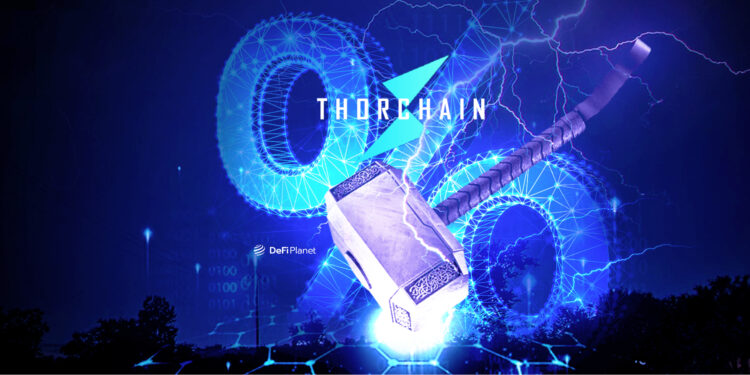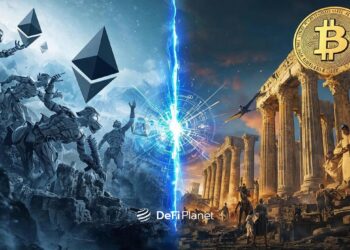It is almost impossible to talk about DeFi without borrowing and lending. Prominent DeFi protocols like Maker, Aave, and Compound, through blockchain technology and smart contracts, have introduced new paradigms to capital management.
DeFi lending mirrors traditional borrowing and lending services offered by banks. However, unlike conventional bank loans, it empowers individuals to act as their own bank and banker. They can lend their assets, earning interest on these loans.
Users can securely lock their crypto assets on the DeFi lending platform without intermediaries. Borrowers can directly obtain loans by providing collateral based on the platform’s specific criteria. Everything is done in a trustless manner and governed entirely by software algorithms.
Nonetheless, there are still significant setbacks to mainstream adoption because of inherent technological limitations and the evolving DeFi culture. For instance, fluctuating interest rates pose a significant challenge in DeFi lending.
To illustrate, even though one may earn a 6.7% APY on a lending protocol today, that rate could rise to 10% tomorrow or plummet to 1% a week later. This volatility makes it challenging for both individuals and institutions to achieve consistent and reliable returns from DeFi lending platforms.
This is where THORchain’s new offering, a zero-interest-free lending product, is truly groundbreaking. The lending product is refreshingly simple: it has no liquidations, no interest charges, and no time constraints.
However, before delving into THORchain’s innovative approach, let’s explore what the protocol is all about.
What is Thorchain?

Thorchain emerged as a response to a critical challenge within the DeFi ecosystem. Initially, the ecosystem lacked a unified platform enabling users to seamlessly trade all assets without the complexity of selecting different DEXs for various token standards or cryptocurrencies.
Each blockchain introduced its own set of DEXs or lending protocols, each featuring unique tradable token standards (e.g., ERC-20 for Ethereum, BEP-20 for Binance, and SOL for Solana). What was missing was the capability for instantaneous trading within a single protocol.
THORChain was created as an immutable decentralized exchange facilitating asset swaps across different blockchain networks. This means users can directly exchange a wide range of cryptocurrencies, including Bitcoin, Ethereum, Litecoin, Bitcoin Cash, Binance Chain, Tether, ERC-20 tokens, and more, all from their wallets on the platform.
The primary objective of THORChain is to provide liquidity for all supported cryptocurrencies. It seeks to connect buyers and sellers in the crypto market, making trading more accessible and seamless without relying on central authorities.
Within THORChain, users can swap assets effortlessly, without the need for order books, similar to centralized exchanges, but in a trustless and decentralized manner.
THORChain stands out from other cross-chain protocols in two significant ways:
- It doesn’t wrap assets before swapping. Instead, it directly employs native assets on THORChain, conducting transparent swaps through liquidity pools.
- It operates its own blockchain, effectively serving as a Layer 1 cross-chain decentralized exchange.
How does THORChain work?
THORChain operates on a similar model to the one popularized by Uniswap. The protocol runs a liquidity pool, and just like in Uniswap, two user groups are directly involved in the pool: Liquidity Providers (LPs) and Traders.
- LPs are users who deposit assets (such as native Bitcoin or Ethereum) into the pools to earn yields (or interests).
- Traders are users who seek to exchange one asset for another, like swapping native ETH for native BTC, so that they achieve their separate aims. They pay “trading fees” whenever they conduct transactions, and LPs earn interest or yields through these fees.
But to make this system work across multiple blockchains, THORChain introduces a third user group: Node Operators.

Node Operators are responsible for running THORNodes, which include the THORChain Node and nodes for various supported blockchains like Bitcoin and Ethereum.
You can think of THORNodes as “fragments” of centralized exchange wallets. But instead of centralized custodians holding the wallet keys, these nodes collectively hold the keys in a multi-signature arrangement using Threshold Signatures. This ensures decentralized control over the liquidity pools, eliminating the need for centralized servers. Thus, node operators are effectively validators.
When a user initiates a trade, validating nodes detect and reach a consensus on the transaction. For instance, when swapping ETH for BTC, the Ethereum nodes confirm the receipt of ETH, and the Bitcoin nodes collectively sign and send the BTC transaction to the user. At least 2 out of 3 validating nodes must agree for an outbound transaction to be approved.
THORChain liquidity pools are more like wallets controlled in a decentralized manner by these node operators rather than being managed by any centralized server.
The RUNE Asset
RUNE, THORChain’s native token, plays multiple vital roles in the protocol’s operations. Validators in the THORChain network use RUNE to secure and validate transactions through the Cosmos Tendermint Proof-of-Stake (PoS) consensus mechanism. To participate, every validator or node in the THORChain network must stake a minimum of 1 million RUNE.
The RUNE token serves as the foundational asset for other tokens within liquidity pools and transaction settlements. It maintains a 1:1 ratio with other assets. For instance, if an LP deposits $50k in BTC, it’s advisable to simultaneously deposit an equal amount of $50k in RUNE. Neglecting this balance triggers an automatic exchange of half their assets for RUNE assets.
Furthermore, RUNE acts as collateral for THORChain nodes in the ecosystem. To explain, THORChain node operators are required to deposit twice the amount of RUNE they stake in the liquidity pool. This measure ensures network security. If a node operator attempts to misappropriate assets, the system penalizes them by reducing their bond value.
How Thorchain’s Zero-Interest Lending Works

As we have seen, Thorchain was initially designed to streamline cross-chain token exchange and trading. However, it recently expanded its functionality to include a borrowing and lending feature. On August 21, 2023, the protocol’s developers introduced the option for users to engage in lending and borrowing activities with the promise of “no liquidations, no interest, and no expiration.”
Borrowers are granted a high degree of flexibility, with their borrowing capacity directly linked to their collateral, depending on the current market conditions. In most cases, users can borrow within a range of 200% to 500% of their collateral value.
In typical lending setups, borrowers face the possibility of their collateral being sold off if its value drops too much. But THORChain’s approach removes this risk by treating the collateral as equity. As a result, if the collateral’s value falls below the debt amount, it’s not an issue because the stored equity covers it. This approach provides users with a more user-friendly experience and eliminates the need for borrowers to constantly monitor asset prices.
THORChain loans come with a minimum 30-day duration. After this initial 30-day period, borrowers can repay their debt anytime to regain their collateral. Partial payments are allowed, but full collateral release occurs only upon complete debt repayment. Importantly, borrowers can repay their debt using any THORChain-supported asset, including stablecoins such as USDC, USDT, BUSD, LUSD, GUSD, USDP, and DAI.
What Are the Consequences of this Innovative Offering?
THORChain’s zero-interest approach to lending marks a significant innovation in the DeFi world. It effectively addresses the issue of fluctuating interest rates, ensuring users have a consistent and reliable experience with borrowing and lending.
By removing interest, the protocol encourages borrowers to hold onto their loans for longer. This approach aligns the interests of borrowers with the protocol and fosters a mutually beneficial ecosystem.
This new lending product also enhances the protocol’s value. Moreover, Thorchain already enables users to trade assets without the need for asset wrapping. Additionally, the protocol’s technical advantages, such as cross-chain capabilities and this novel fee model, open up possibilities for various use cases beyond its original intended use cases.
However, there is a big question looming over the potential problems of THORChain’s zero-interest model, particularly in terms of platform security. THORChain’s journey has already been marked by serious security challenges, including 3 consecutive hacks in 2021.
The fear of many is that this zero-interest model may attract opportunistic individuals who see an opportunity to exploit the platform’s vulnerabilities. Without the safeguard of interest charges, these actors may seek to manipulate the system or engage in fraudulent activities, potentially compromising the overall security and integrity of the platform.
These potential security concerns highlight the importance of implementing stringent security protocols and continuously monitoring the platform to prevent and detect any malicious activities. THORChain must prioritize robust security measures to safeguard user funds and maintain trust in the platform, even without the traditional economic incentives provided by interest charges.
Thorchain’s zero-interest lending is a substantial leap forward in the evolution of DeFi, and its continued development and adoption will be fascinating to watch.…
Disclaimer: This article is intended solely for informational purposes and should not be considered trading or investment advice. Nothing herein should be construed as financial, legal, or tax advice. Trading or investing in cryptocurrencies carries a considerable risk of financial loss. Always conduct due diligence.
If you would like to read more articles (news reports, market analyses) like this, visit DeFi Planet and follow us on Twitter, LinkedIn, Facebook, Instagram, and CoinMarketCap Community.
“Take control of your crypto portfolio with MARKETS PRO, DeFi Planet’s suite of analytics tools.”





















